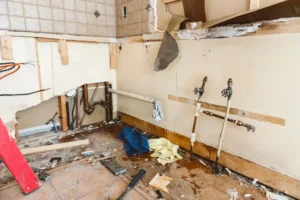Imagine coming home to find a leaking pipe or a flooded basement. Water damage, a common headache for homeowners, can strike at any time, leading to more than just the immediate inconvenience and repair costs. One of the hidden dangers lurking behind water damage is the potential for mold growth, a concern that can have lasting impacts on both your home and your health. Understanding the risks and taking swift action can make all the difference.
In this article we’ll explore the critical link between water damage and mold, providing homeowners with the knowledge to protect their properties and well-being. We’ll discuss how to identify and prevent mold going forward, and why it’s ideal to partner with an expert.
A Closer Look at Water Damage
Water damage in a home can result from various sources like burst pipes, roof leaks, flooding, or even humidity. It’s not just about the immediate mess and damage, it’s about the ongoing moisture problem that can seep into walls, floors, and furniture, creating an ideal breeding ground for mold.
Differentiating between sudden water incidents and gradual leaks is crucial, as both can lead to significant mold issues if not addressed promptly. Homeowners should be aware of the common causes of water damage and monitor their homes for any signs of moisture intrusion or accumulation, to give themselves the best chance at preventing long-term issues.
The Connection Between Water Damage and Mold
Mold thrives in moist, damp environments, and excess water from leaks, floods, or high humidity provides the perfect conditions for mold spores to settle and multiply. Within 24 to 48 hours of water exposure, mold can start to grow on surfaces, hidden in walls, or under carpets. This rapid growth can lead to a full-blown mold infestation if the water damage is not quickly and properly addressed.
Identifying Mold after Water Damage
Early identification can prevent a minor mold issue from escalating into a major problem. Look for visible signs of mold, which may appear as speckled black, green, or white patches on surfaces, especially in areas where water has accumulated. A musty smell is often a telltale sign of hidden mold, particularly in basements, attics, and behind walls. Additionally, excessive humidity and condensation on windows can indicate a conducive environment for mold growth.
Preventing Mold after Water Damage
Here are the best steps to prevent mold in the future.
- Quickly Dry Affected Areas: Use fans, dehumidifiers, and natural ventilation to dry out wet areas promptly. The sooner you remove the moisture, the less chance mold has to grow.
- Remove Water-Damaged Materials: Items like carpets, insulation, and drywall that have been soaked should be removed and replaced to prevent mold from taking hold.
- Clean and Disinfect: After drying the area, clean and disinfect all affected surfaces to kill any mold spores that might be present.
- Monitor Humidity Levels: Keep indoor humidity below 60% to discourage mold growth. Use hygrometers to monitor humidity levels and ensure they remain in a safe range.
- Inspect Regularly: Regularly check areas prone to water damage and mold growth, especially after incidents of water exposure, to catch any new mold development early.
RestoTek Leads in Eliminating Mold After Water Damage
Facing mold from water damage? RestoTek provides expert mold remediation and water damage restoration. Don’t let water damage or mold put your home at risk. Protect your property and health by ensuring water damage and mold are addressed by professionals. Contact RestoTek today for a professional assessment and the peace of mind that comes with knowing your home is in expert hands.



